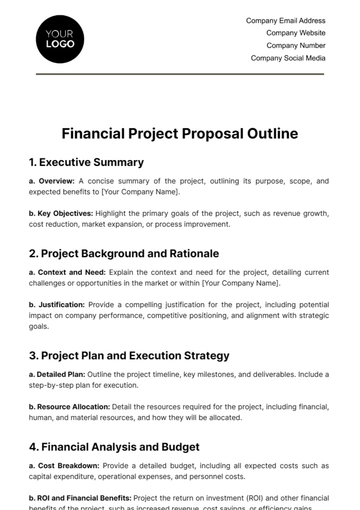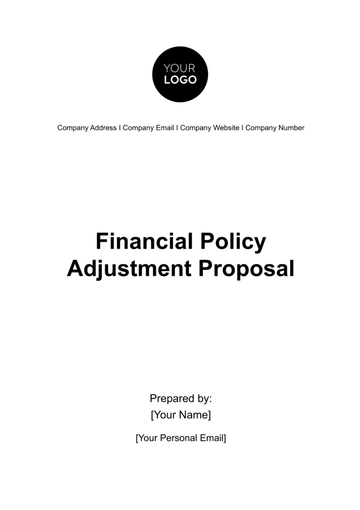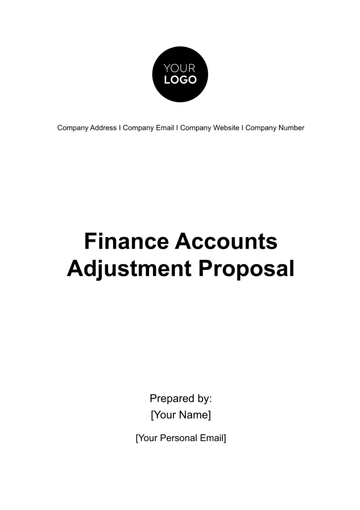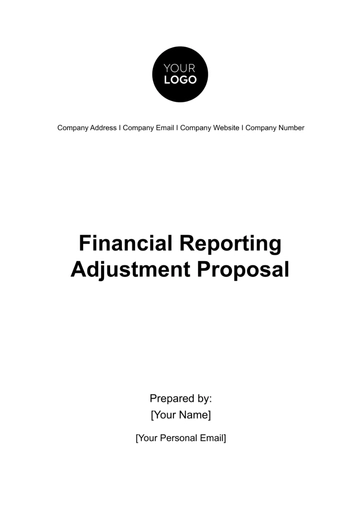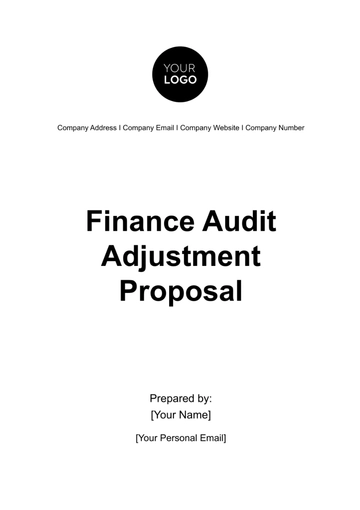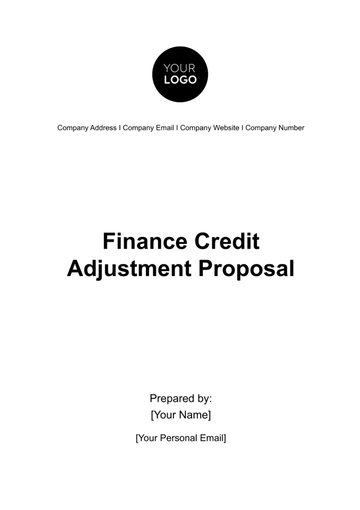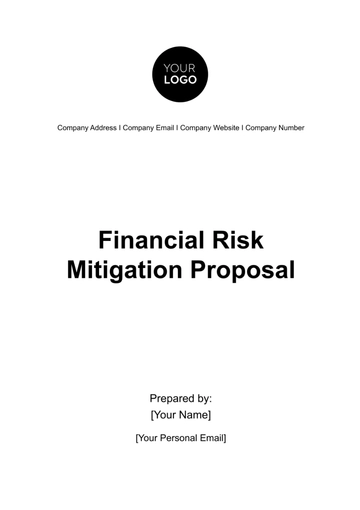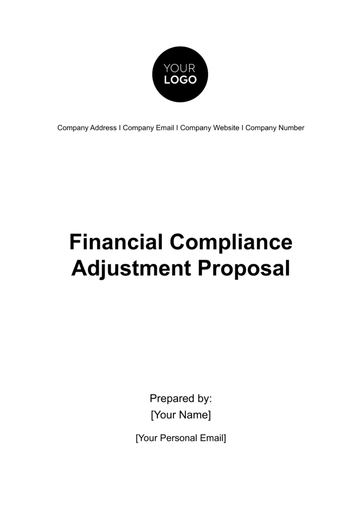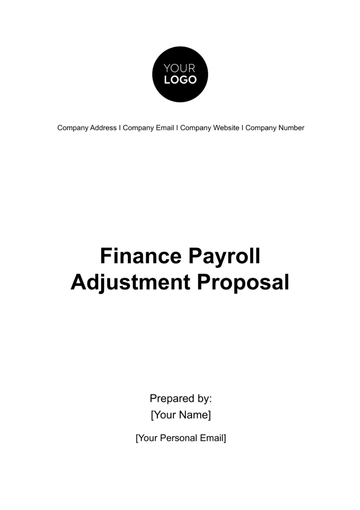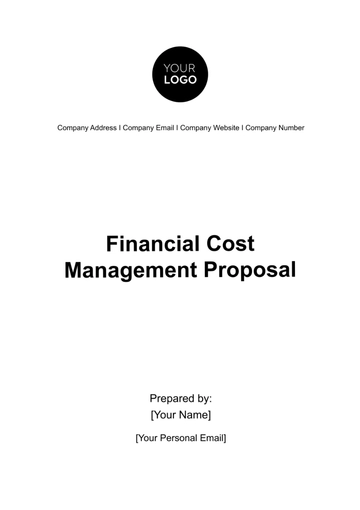Free Financial Cost Adjustment Proposal
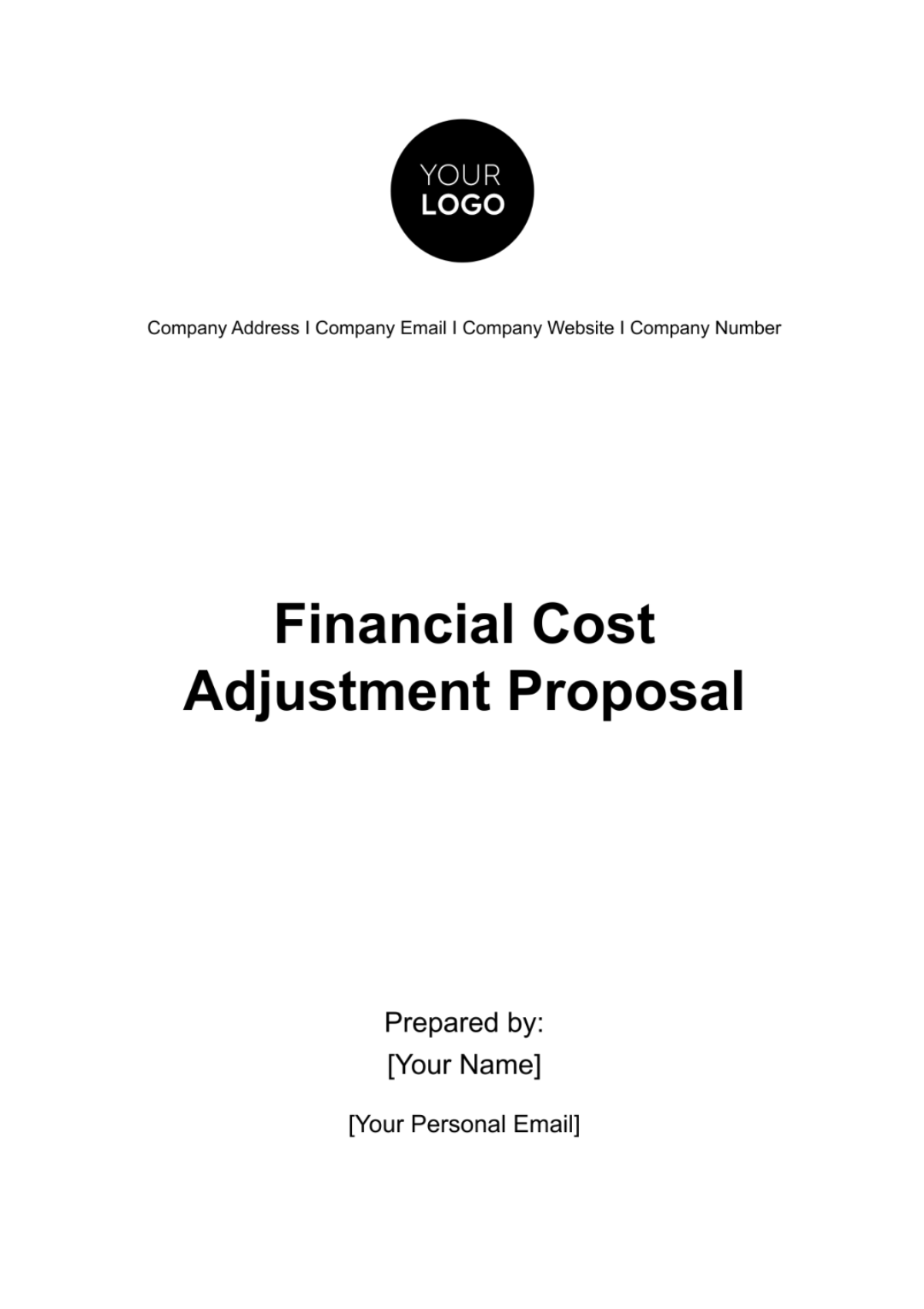
I. Introduction
As a leading entity in the technology hardware industry, we navigate a dynamic business landscape characterized by evolving market conditions and regulatory changes. In this context, ensuring precise and reflective cost representation is imperative. It is to ensure maintaining our competitive edge and meeting the expectations of our stakeholders.
II. Purpose
The primary purpose of this proposal is to rectify inaccuracies in our financial records, align costs with current market realities, and enhance the overall accuracy of financial reporting. This initiative falls within the broader scope of our ongoing commitment to financial excellence.
III. Background
A. Previous Financial Statements
Upon a comprehensive review of our previous financial statements, discrepancies have been identified in the allocation and reporting of certain costs. These errors, though unintentional, necessitate immediate attention to uphold the accuracy and integrity of our financial reporting.
B. Market Conditions
The technology hardware industry has witnessed notable shifts, including fluctuations in currency exchange rates and changes in commodity prices. These changes impact our cost structures, requiring a proactive approach to align our expenses with current market realities.
C. Internal Factors
Internal factors, such as adjustments in production processes and evolving accounting methods, have contributed to the need for realigning our cost structures. Addressing these factors is crucial to maintaining financial accuracy and ensuring compliance with industry standards.
IV. Objectives
A. Identify and Correct Errors
Thoroughly investigate and correct errors identified in previous financial statements to restore accuracy and reliability.
B. Align Costs with Market Realities
Adjust cost structures to reflect current market conditions, ensuring our pricing remains competitive.
C. Improve Financial Reporting Accuracy
Enhance the accuracy and transparency of financial reporting through precise cost representation, fostering trust among stakeholders.
V. Justification
A. Error Correction
We have identified specific errors in the allocation of production costs, leading to discrepancies in our reported financial figures. The correction of these errors is imperative to maintain the trust of our investors and comply with accounting standards.
B. Market-Driven Adjustments
To stay competitive in the technology hardware industry, it is essential to adjust our cost structures in response to market-driven factors, such as increased raw material costs and changing consumer preferences. This adjustment ensures our products remain both high-quality and competitively priced.
C. Regulatory Compliance
Changes in regulatory requirements necessitate adjustments in our accounting methods. Ensuring compliance is not only a legal obligation but also reinforces our commitment to ethical business practices.
VI. Cost Adjustment
A. Methodology
Review of Accounting Systems
Engaged an external audit firm to conduct a comprehensive review of our accounting systems, focusing on identifying potential errors or inconsistencies in the allocation of costs.
Utilized advanced data analytics tools to perform a granular analysis of transaction records, ensuring the accuracy of cost entries.
Historical Data Analysis
Conducted a multi-year analysis of historical financial data, applying statistical methods to identify trends and patterns in cost allocation.
Collaborated with data scientists to deploy predictive modeling, forecasting potential future discrepancies based on historical data trends.
B. Considerations
Changes in Raw Material Costs
Leveraged real-time market data and engaged with industry experts to assess the impact of fluctuations in raw material costs.
Implemented sensitivity analysis to quantify the potential effects of varying raw material costs on production expenses.
Adjustments in Production Processes
Conducted a thorough process optimization study to identify areas for efficiency improvement and cost reduction.
Collaborated with production engineers to assess the impact of any modifications in production processes on overall costs.
Evolving Market Dynamics
Engaged in continuous market monitoring, utilizing market intelligence tools to track changing consumer demands and competitor activities.
Conducted scenario analysis to anticipate potential market shifts and their corresponding impacts on our cost structures.
C. Quantification of Adjustment
The table below presents a breakdown of the quantification of adjustments, providing specific details for each cost category:
Cost Category | Original Amount | Proposed Adjustment |
[Production Costs] | [$2,500,000] | [$750,000] |
The adjustment is imperative as it ensures the alignment of our cost structures with current market realities and industry standards. By incorporating advanced methodologies and considering dynamic factors, we not only rectify historical inaccuracies but also position ourselves to proactively respond to future changes. This precision enhances the accuracy of our financial reporting, instilling confidence in our stakeholders. The adjustment data reflects our commitment to continuous improvement, optimizing processes, and adapting to market dynamics for sustained competitiveness.
VII. Impact Analysis
A. Financial Statements
Income Statement Impact
The adjustment in production costs directly addresses discrepancies identified during the review, resulting in a more accurate portrayal of our operational profitability. As a consequence, net income will more faithfully reflect our true earnings, aligning financial reporting with the economic reality of our operations.
Balance Sheet Impact
Adjustments in overhead expenses contribute to a more precise depiction of our financial position on the balance sheet. The corrected figures enhance the transparency of our assets and liabilities, ensuring a more realistic representation for stakeholders.
B. Key Financial Metrics
Gross Profit Margin
Adjustments in production costs will influence the gross profit margin, providing stakeholders with a clearer understanding of our operational efficiency. This correction aligns the metric more closely with actual production costs, offering a more reliable measure of cost-effectiveness.
Cost of Goods Sold (COGS)
Distribution cost adjustments impact COGS, ensuring that metrics associated with the cost of delivering products to customers accurately reflect the economic costs incurred. This alignment contributes to a more accurate assessment of our cost structure and profitability.
Return on Assets (ROA) and Return on Equity (ROE)
Adjustments in overhead expenses influence key metrics such as ROA and ROE, providing stakeholders with a more accurate evaluation of our financial performance. The corrections contribute to a realistic assessment of our profitability relative to our assets and equity, reinforcing confidence in our financial health.
C. Cash Flow Implications
Adjustments in production and distribution costs will directly impact cash from operating activities on the cash flow statement.
A more accurate representation of cash inflows and outflows ensures stakeholders have reliable insights into our liquidity and ability to meet financial obligations.
D. Investor Confidence
The need for adjustment stems from our commitment to transparent and accurate financial reporting, addressing errors and aligning our statements with market realities.
Enhanced financial statements and key financial metrics instill confidence in investors, providing them with a clear and trustworthy understanding of our financial position and performance.
E. Regulatory Compliance
The adjustments are imperative for maintaining regulatory compliance, addressing inaccuracies in financial reporting that could lead to potential regulatory issues.
Aligning our reporting with accounting standards ensures adherence to ethical business practices, upholding trust with regulators and other stakeholders.
F. Operational Decision-Making
The adjustments offer our management team a more accurate understanding of cost structures, aiding in operational decision-making.
From production processes to pricing strategies, the corrections provide realistic cost data, enabling more informed and effective decision-making.
VIII. Implementation Plan
A. Data Collection and Validation
Identification of Adjustments
The finance team will work closely with external auditors to identify specific adjustments needed, focusing on production costs, distribution costs, and overhead expenses.
Utilizing advanced data analytics, discrepancies will be pinpointed, ensuring a comprehensive understanding of the required adjustments.
Validation of Adjustments
Data validation procedures will be employed to ensure the accuracy of identified adjustments.
External experts and internal auditors will collaborate to validate the adjustments against historical data and industry benchmarks.
B. Communication and Training
Internal Stakeholder Communication
A transparent communication plan will be implemented to inform relevant internal stakeholders, including finance teams and department heads, about the adjustments.
Training sessions will be conducted to ensure that teams understand the rationale behind the adjustments and are equipped to adapt to the changes.
External Stakeholder Communication
External communications will be strategized to transparently communicate the adjustments to investors and other external stakeholders.
Clear messaging will be crafted to convey the commitment to accurate financial reporting and to address any potential concerns proactively.
C. Timing and Logistics
Phased Implementation
The implementation will be phased to minimize disruption to ongoing financial activities.
Initial adjustments will focus on high-priority areas with a phased rollout to other segments of financial records.
Logistics of Adjustment Incorporation
The adjustment process will be integrated into existing financial reporting workflows to ensure seamless incorporation.
Dedicated teams will be assigned to oversee the logistics, with regular check-ins to monitor progress and address any emerging issues.
D. Monitoring and Quality Assurance
Continuous Monitoring
Ongoing monitoring mechanisms will be implemented to track the effectiveness of the adjustment incorporation.
Key performance indicators (KPIs) related to financial accuracy and stakeholder feedback will be continuously assessed.
Quality Assurance Procedures
Quality assurance protocols will be established to validate the accuracy of adjusted financial records.
Internal and external audit teams will collaborate to conduct periodic reviews to ensure the ongoing integrity of the financial data.
E. Documentation and Reporting
Comprehensive Documentation
Robust documentation processes will be implemented to capture the details of each adjustment, including the rationale, methodologies employed, and supporting evidence. This documentation will serve as a comprehensive record for internal review and potential external audits.
Regular Reporting
Regular reporting mechanisms will be established to keep stakeholders informed about the progress of adjustment incorporation.
Timely updates will be provided through designated channels to maintain transparency and address any inquiries.
IX. Monitoring and Review
A. Ongoing Monitoring
Financial Metrics
Continuous monitoring of key financial metrics will be conducted to track the impact of adjustments on metrics.
Regular assessments will provide insights into the effectiveness of adjustments with operational realities.
Cash Flow Dynamics
Ongoing monitoring of cash flow implications resulting from adjustments will be crucial to understanding the impact on operating activities.
Timely assessments will ensure that adjustments positively contribute to maintaining liquidity and meeting financial obligations.
B. Stakeholder Feedback
Internal Stakeholders
Regular feedback sessions with internal stakeholders, including finance teams and department heads, will be conducted to gauge their experience with the adjusted financial records.
External Stakeholders
External stakeholder feedback, including that from investors and regulatory bodies, will be actively sought through surveys and communication channels.
Responsive actions will be taken to address concerns and maintain transparency, fostering trust among external stakeholders.
C. Quality Assurance Reviews
Internal Audit
Internal audit teams will conduct periodic reviews to ensure the ongoing accuracy and integrity of adjusted financial records.
Findings from internal audits will inform continuous improvement efforts and identify areas for refinement in the adjustment process.
External Audit Collaboration
Collaboration with external audit firms will extend beyond the initial adjustment phase to include ongoing reviews.
Regular communication with external auditors will facilitate the alignment of internal processes with external audit requirements.
X. Conclusion
In conclusion, this proposal represents a critical step in ensuring the financial health and integrity of our organization. By addressing identified discrepancies we are proactively enhancing the accuracy of our financial statements and key metrics. The adjustments are strategic measures to align our cost structures with current market realities and industry standards. The implementation plan also provides a systematic approach to incorporate these adjustments seamlessly into our financial records, minimizing disruptions. As we embark on this journey, we remain committed to ongoing monitoring, stakeholder engagement, and continuous improvement, ensuring the sustained effectiveness of these adjustments.
- 100% Customizable, free editor
- Access 1 Million+ Templates, photo’s & graphics
- Download or share as a template
- Click and replace photos, graphics, text, backgrounds
- Resize, crop, AI write & more
- Access advanced editor
Propose financial cost adjustments with confidence using the Financial Cost Adjustment Proposal Template from Template.net! This editable template transcends the ordinary, offering a dynamic format for proposing cost adjustments. Customizable to your unique needs, ensuring clarity and effectiveness in your cost adjustment proposals! Make your proposal seamlessly using the intuitive AI Editor Tool now!
You may also like
- Business Proposal
- Research Proposal
- Proposal Request
- Project Proposal
- Grant Proposal
- Photography Proposal
- Job Proposal
- Budget Proposal
- Marketing Proposal
- Branding Proposal
- Advertising Proposal
- Sales Proposal
- Startup Proposal
- Event Proposal
- Creative Proposal
- Restaurant Proposal
- Blank Proposal
- One Page Proposal
- Proposal Report
- IT Proposal
- Non Profit Proposal
- Training Proposal
- Construction Proposal
- School Proposal
- Cleaning Proposal
- Contract Proposal
- HR Proposal
- Travel Agency Proposal
- Small Business Proposal
- Investment Proposal
- Bid Proposal
- Retail Business Proposal
- Sponsorship Proposal
- Academic Proposal
- Partnership Proposal
- Work Proposal
- Agency Proposal
- University Proposal
- Accounting Proposal
- Real Estate Proposal
- Hotel Proposal
- Product Proposal
- Advertising Agency Proposal
- Development Proposal
- Loan Proposal
- Website Proposal
- Nursing Home Proposal
- Financial Proposal
- Salon Proposal
- Freelancer Proposal
- Funding Proposal
- Work from Home Proposal
- Company Proposal
- Consulting Proposal
- Educational Proposal
- Construction Bid Proposal
- Interior Design Proposal
- New Product Proposal
- Sports Proposal
- Corporate Proposal
- Food Proposal
- Property Proposal
- Maintenance Proposal
- Purchase Proposal
- Rental Proposal
- Recruitment Proposal
- Social Media Proposal
- Travel Proposal
- Trip Proposal
- Software Proposal
- Conference Proposal
- Graphic Design Proposal
- Law Firm Proposal
- Medical Proposal
- Music Proposal
- Pricing Proposal
- SEO Proposal
- Strategy Proposal
- Technical Proposal
- Coaching Proposal
- Ecommerce Proposal
- Fundraising Proposal
- Landscaping Proposal
- Charity Proposal
- Contractor Proposal
- Exhibition Proposal
- Art Proposal
- Mobile Proposal
- Equipment Proposal
- Student Proposal
- Engineering Proposal
- Business Proposal








